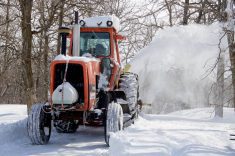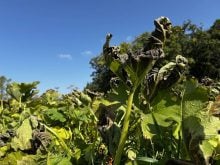In the face of volatility on all sides, some Manitoba farmers are leaving nothing to chance — and that’s a good call, says one expert.
“It’s overwhelming uncertainty,” said Darren Bond, a farm management specialist with the province.
At the midpoint of March, hulking heaps of snow had just begun to melt. Despite flood predictions looming, it wasn’t clear what that would do for soil moisture levels.
Canadian Pacific Railway was on the cusp of an employee lockout after a winter already riddled with supply chain woes. Fertilizer prices kept a steady upward chug.
Read Also

What is perfect Christmas weather?
What is ‘perfect’ Christmas weather on the Prairies? Here’s where you should head this holiday, according to historical weather data.
War in Ukraine cast further unpredictability over global supplies of grain.
Yet, some optimism was in the air — let’s start there.
The good
“The moisture situation has improved unbelievably,” said Trevor Hadwen, agroclimate specialist with Agriculture and Agri-Food Canada (AAFC). He spoke with the Co-operator on March 15.
At the end of February, most of agro-Manitoba was classified as under severe drought, with some areas improved to moderate drought or ‘just’ abnormally dry, according to AAFC’s drought map.
In October, a large portion of the province was under extreme drought, with the area north of Winnipeg into the Interlake under exceptional drought — the highest classification AAFC has. The southwest was faring a little better, sitting under severe drought — most of that corner of the province has been downgraded to moderate drought or abnormally dry.
It’s a remarkable turnaround, said Hadwen. Much of Saskatchewan and Alberta hasn’t been as fortunate.

In its March 17 flood forecast, the province said snowpack in the Interlake region averaged a snow water equivalent (SWE) of 70 to 110 mm (three to four inches), the Shellmouth Resevoir basin had an average SWE of 75 mm (three inches), and the eastern side of the Red River Basin had an SWE of up to 150 mm (six inches).
How that snow translates into filled dugouts or soil moisture will depend on how slowly it melts — more on that later.
If not for severely depleted soil moisture reserves, Manitoba would be in better shape than last spring, Hadwen added.
Another positive — grain prices are still high. At the beginning of March, Western Red Spring wheat was more than $13/bu., and just below that the next week, based on reports from the province.
Canola was nearly $24/bu. at the beginning of the month and climbed to $25/bu. the next week. Soybeans were just above $19/bu.
Despite high fertilizer prices and other climbing costs, farmers have a good shot at profitability if prices hold, said Bond.

“I think there’s some huge opportunities if we grow a decent crop,” said Robert Brunel who farms near Ste. Rose du Lac. “I don’t think we can discount that at all.”
“I’m optimistic,” said Colin Penner, who farms near Elm Creek. “I think if we have an average crop we’re going to do quite well.”
Various variables
Fertilizer costs were already on the ascent last fall, and despite faint hopes it would come down again, the farmers the Co-operator spoke to had locked down supplies early.
Nitrogen urea was about $500 per metric ton in early 2021, said Bond. By summer it was about $700/MT, and by fall was around $1,000/MT. Now it’s around $1,300/MT.
Bond said in the province’s cost-of-production guide for 2021, canola fertilizer costs were $88/acre. At today’s price, it’s over $200/acre.
Brunel said he positions himself pretty aggressively most years but was even more so last fall. He said he had the majority of his fertilizer bought between September and November and did “fairly decently” on price.
It wasn’t easy to spend that money so early, but it put them in a better spot, he added.
Penner said his family started looking at fertilizer in September because they’d been, “hearing rumblings here and there about different things going crazy.”
They lucked out on their timing, he added.
After a pretty dry to catastrophic year, Penner said they were concerned injecting anhydrous ammonia would damage their equipment, so they opted to buy urea and store it in bins they’d bought to store phosphorus.
They then bought and stored phosphorus in old bins. The phosphorus wasn’t at the lowest price, Penner said. It would have been nice to buy in August.

Jeff Elder, who farms near Wawanesa, said he’d hoped prices would come down and waited until November to buy.
“I decided that if I wanted to sleep at night, I should just buy the rest of my fertilizer and then take that risk off of the table,” he said. “I’m glad I did it.”
Herbicide supplies are another big variable as production issues have caused supply concerns, said Bond. COVID-19 and transportation woes have compounded the issue.
“There may be some shortages this year,” said Bond. “This is the year that nothing, I don’t think, should surprise us anymore.”
The important thing now is to secure those supplies or, if needed, have conversations with supplier about good alternatives, Bond added.
Elder said he doesn’t normally carry over a lot of chemical but had opted to buy and store half of his probable use and store it over winter.
Penner said he also had more chemicals in his shed than he’d ever had before at this time of year.

“We’re nervous about, kind of, the supply chain,” he said.
He also has enough fuel at home to get through seeding, Penner added.
It might sound a bit like doomsday prepping, but it’s a good idea, said Bond.
“We’ve taken secure supplies for granted for so long, everywhere from fuel to inputs. There is a possibility that there may be some minor interruptions,” Bond said.
One more variable is the availability of equipment parts.
“How do you plan for the unknown breakdown and make sure that you have timely parts available, I think, is really top of mind for me,” Brunel said.
They’ve already had delays getting parts over winter, he added.
It’s times like these when knowing your costs, your break-even, and having a solid plan is important — even if only to make pivoting to a backup plan easier later on, said Bond.
Where’s the water?
A good plan, however, will need a good recharge of groundwater.
Due to normal to above-normal snowfall, the province’s March 17 flood forecast says the risk is high for “moderate to major” spring flooding along the Red River and its tributaries (the Roseau, Rat and Pembina rivers).
There’s a high risk of moderate flooding in the Assiniboine River and its tributaries such as the Souris River.
However, “we can have spring flooding and drought at the same time,” said Hadwen — e.g. flood along the Red River and drought outside the flood plain.
Both soil moisture and dugouts and reservoirs need refilling, Hadwen said — and these require different conditions.
A slow melt with a thaw during the day and freezing overnight tends to benefit soil moisture, said Hadwen. Whereas if things freeze up for a couple of weeks and then rapidly melt, this will send a lot more water into streams.
Because of the thick layer of snow, the frost is probably not as deep into the ground, which can help water soak in. However, if the soil was moist when it froze, the topsoil will be a layer of ice and delay the melt.
Best-case scenario, he said, is for a bit of a delay in the melt, then a quicker melt to fill dugouts, then some late-spring precipitation to benefit soil moisture.
A caution — soil moisture reserves are gone, said Hadwen. In a hot, dry spell, plants will be vulnerable sooner than usual.
















